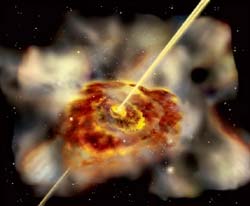This area deals with the fundamental laws and building blocks of nature and how they interact, the properties and the behavior of matter, and research into space and time and their structures.
innovations-report provides in-depth reports and articles on subjects such as astrophysics, laser technologies, nuclear, quantum, particle and solid-state physics, nanotechnologies, planetary research and findings (Mars, Venus) and developments related to the Hubble Telescope.

Researchers from the Universities of Southampton and Glasgow have succeeded in tying knots in light beams.
Using a computer-designed hologram, they created threads of darkness embedded in a laser beam. The hologram bends the direction of optical energy flow, so these dark threads form loops. The loops can then be linked together, or tied into knots.
Dr Mark Dennis, a University of Southampton mathematician, worked in collaboration with Professor Miles Padgett, Dr Johannes

The existence of a new electronic state in superconductors, materials that can carry an electric current without resistance, has been confirmed experimentally according to research to be published in the 12 November 2004 issue of the journal Science by a team led by Ying Liu, associate professor of physics at Penn State. “We have established direct evidence for the existence of an odd-parity superconductor, which previously had been theorized but never demonstrated in an unambiguous experiment,

In June, researchers from the University of Rochester announced they had located a potential planet around another star so young that it defied theorists’ explanations. Now a new team of Rochester planet-formation specialists are backing up the original conclusions, saying they’ve confirmed that the hole formed in the star’s dusty disk could very well have been formed by a new planet. The findings have implications for gaining insight into how our own solar system came to be, as well as finding

In a paper published online today in Science, a group of researchers led by David Awschalom, a professor of physics and electrical and computer engineering at the University of California, Santa Barbara, reports the observation of the spin Hall effect. This publication ends a 33-year long effort aimed at this discovery.
The Hall effect, named after American physicist Edwin Hall who discovered it in 1879, occurs when an electric current flows through a conductor in a magnetic field

Pluto’s status as our solar system’s ninth planet may be safe if a recently discovered Kuiper Belt Object is a typical “KBO” and not just an oddball.
Astronomers have new evidence that KBOs (Kuiper Belt Objects) are smaller than previously thought.
KBOs – icy cousins to asteroids and the source of some comets – are the leftover building blocks of the outer planets. Astronomers using the world’s most powerful telescopes have discovered about 1,000 of these objects orb

An international team led by an Edinburgh astronomer have discovered that by studying polarised light from black holes they can focus much more closely on what exactly is going on around them. The work is published this week in the monthly notices of the Royal Astronomical Society on November 11th.
Studying black holes at the centre of galaxies is difficult. A huge amount of material is falling on to the centre in an active black hole system, and this falling material is thought